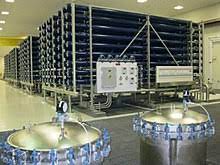Reverse Osmosis (RO) is a membrane-technology filtration method that removes many types of large molecules and ions from solutions by applying pressure to the solution when it is on one side of a selective membrane.
The result is that the solute is retained on the pressurized side of the membrane and the pure solvent is allowed to pass to the other side.
To be selective this membrane should not allow large molecules or ions through the pores (holes), but should allow smaller components of the solution (such as the solvent) to pass freely.
In the normal osmosis process, the solvent naturally moves from an area of low solute concentration (High Water Potential), through a membrane, to an area of high solute concentration (Low Water Potential).
The movement of a pure solvent to equalize solute concentrations on each side of a membrane generates osmotic pressure. Applying an external pressure to reverse the natural flow of pure solvent, thus, is reverse osmosis.
The process is similar to other membrane technology applications. However, there are key differences between reverse osmosis and filtration. The predominant removal mechanism in membrane filtration is straining, or size exclusion, so the process can theoretically achieve perfect exclusion of particles regardless of operational parameters such as influent pressure and concentration.
Reverse osmosis, however, involves a diffusive mechanism so that separation efficiency is dependent on solute concentration, pressure, and water flux rate (Crittenden and Rhodes et al, 2005).
Reverse osmosis is most commonly known for its use in drinking water purification from seawater, removing the salt and other substances from the water molecules.
Read Also : Meaning and Factors affecting Sedimentation in Waste-water Treatment

The membranes used for reverse osmosis have a dense barrier layer in the polymer matrix where most separation occurs. In most cases, the membrane is designed to allow only water to pass through this dense layer while preventing the passage of solutes (such as salt ions).
This process requires that a high pressure be exerted on the high concentration side of the membrane, usually 2–17 bar (30–250 psi) for fresh and brackish water, and 40–70 bar (600–1000 psi) for seawater, which has around 24 bar (350 psi) natural osmotic pressure which must be overcome.
Read Also: Industrial Waste-water Treatment Trickle Filters
The Process of Reverse Osmosis

Osmosis is a natural process. When two liquids of different concentration are separated by a semi permeable membrane, the fluid has a tendency to move from low to high solute concentrations for chemical potential equilibrium.
Formally, reverse osmosis is the process of forcing a solvent from a region of high solute concentration through a semi permeable membrane to a region of low solute concentration by applying a pressure in excess of the osmotic pressure.
The largest and most important application of reverse osmosis is to the separation of pure water from seawater and brackish waters; seawater or brackish water is pressurized against one surface of the membrane, causing transport of salt-depleted water across the membrane and emergence of potable drinking water from the low- pressure side.
The membranes used for reverse osmosis have a dense layer in the polymer matrix-either the skin of an asymmetric membrane or an interracially polymerized layer within a thin-film-composite membrane- where the separation occurs.
In most cases, the membrane is designed to allow only water to pass through this dense layer, while preventing the passage of solutes (such as salt ions).
This process requires that a high pressure be exerted on the high concentration side of the membrane, usually 2–17 bar (30–250 psi) for fresh and brackish water, and 40–82 bar (600–1200 psi) for seawater, which has around 27 bar (390 psi) natural osmotic pressure that must be overcome.
This process is best known for its use in desalination (removing the salt and other minerals from sea water to get fresh water), but since the early 1970s it has also been used to purify fresh water for medical, industrial, and domestic applications.
Osmosis describes how solvent moves between two solutions separated by a permeable membrane to reduce concentration differences between the solutions.
When two solutions with different concentrations of a solute are mixed, the total amount of solutes in the two solutions will be equally distributed in the total amount of solvent from the two solutions.
Instead of mixing the two solutions together, they can be put in two compartments where they are separated from each other by a semi permeable membrane. The semi permeable membrane does not allow the solutes to move from one compartment to the other, but allows the solvent to move.
Since equilibrium cannot be achieved by the movement of solutes from the compartment with high solute concentration to the one with low solute concentration, it is instead achieved by the movement of the solvent from areas of low solute concentration to areas of high solute concentration.
When the solvent moves away from low concentration areas, it causes these areas to become more concentrated. On the other side, when the solvent moves into areas of high concentration, solute concentration will decrease.
This process is termed osmosis. The tendency for solvent to flow through the membrane can be expressed as “osmotic pressure”, since it is analogous to flow caused by a pressure differential. Osmosis is an example of diffusion.
In reverse osmosis, in a similar setup as that in osmosis, pressure is applied to the compartment with high concentration. In this case, there are two forces influencing the movement of water: the pressure caused by the difference in solute concentration between the two compartments (the osmotic pressure) and the externally applied pressure.
Read Also: Farming and Care Guide of Rapeseed

